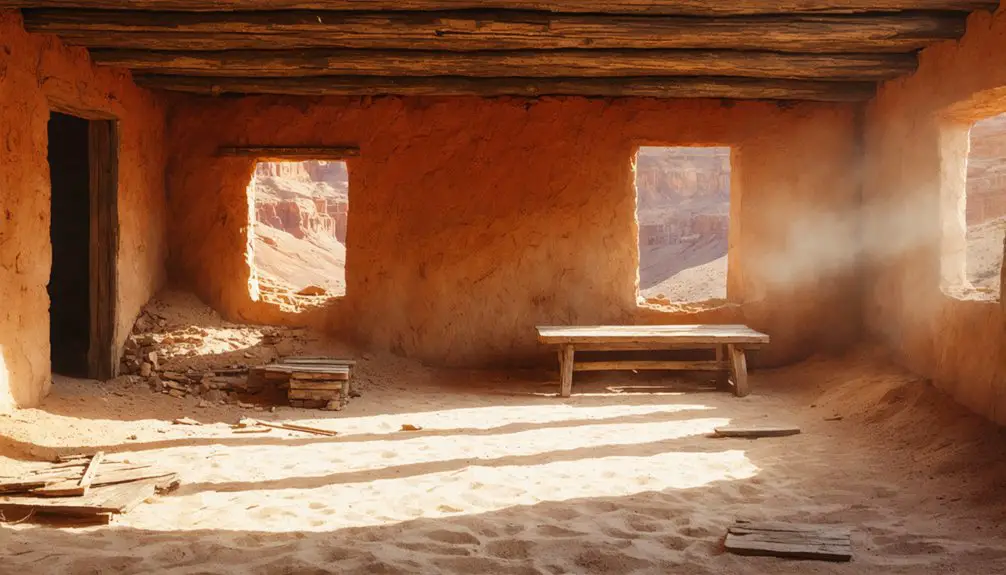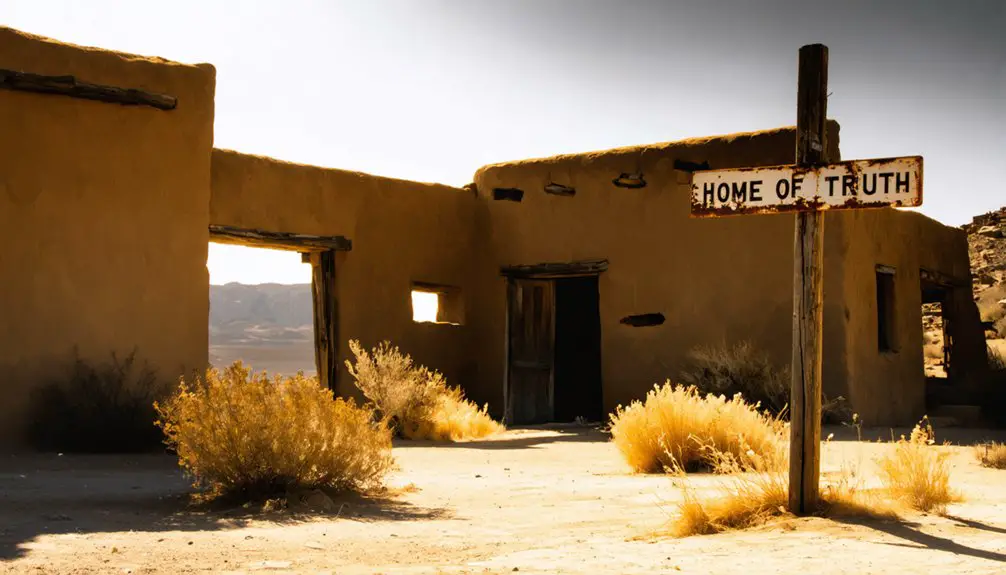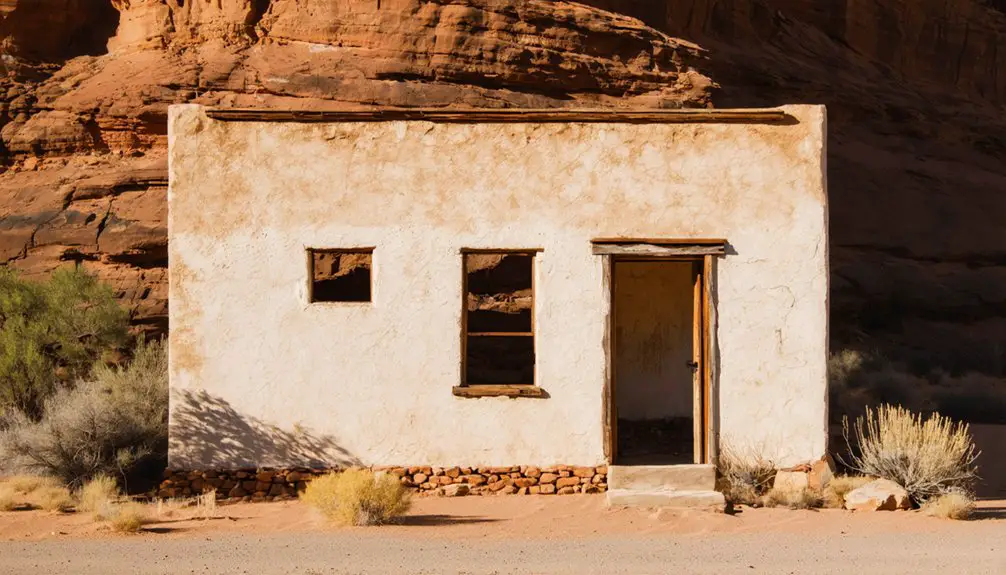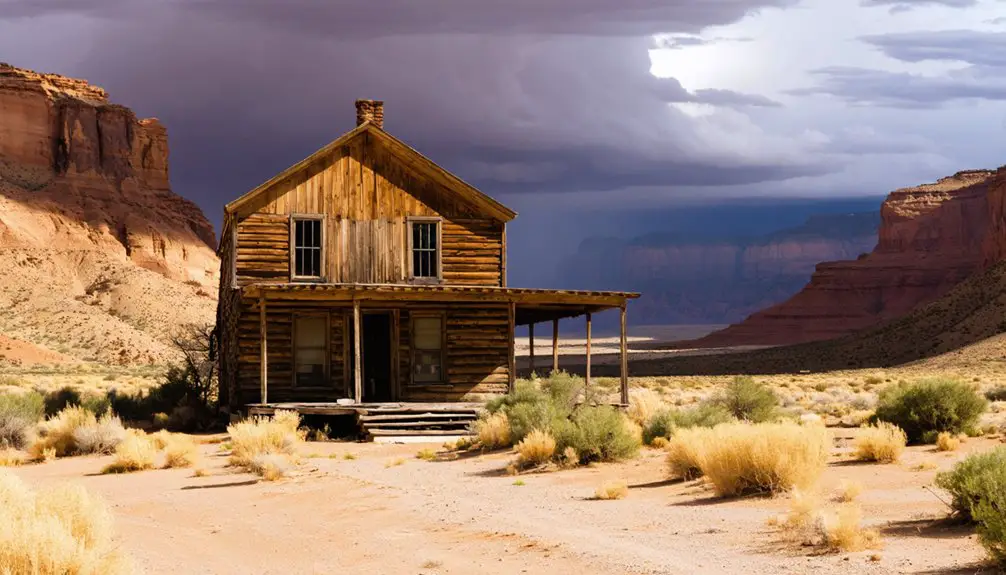You’ll find the Home of Truth ghost town in Utah’s Dry Valley, where Marie Ogden founded her New Age religious colony in 1933. The settlement featured three distinct portals – Outer, Middle, and Inner – representing spiritual progression toward enlightenment. With around 100 followers at its peak, the community thrived until 1940, when failed resurrection attempts and media scrutiny led to its decline. The weathered ruins still stand today, holding secrets of this unique spiritual experiment.
Key Takeaways
- Home of Truth was a spiritual commune established in 1933 in Utah’s Dry Valley by Marie Ogden as a post-apocalyptic sanctuary.
- The ghost town consists of 23 weathered buildings constructed in a simple board and batten style across three designated spiritual portals.
- The community peaked at 100 members but declined rapidly by 1940 following controversies surrounding a failed resurrection attempt.
- Structures remain visible from State Route 211 near Church Rock, though access is restricted due to private property laws.
- The site’s architectural remnants represent a unique blend of New Thought spirituality and Depression-era communal living in Utah’s desert.
A Divine Calling: Marie Ogden’s Vision
Following the death of her husband in 1929, Marie Ogden initiated a profound spiritual journey that would transform her from a grieving widow into a self-proclaimed New Age prophet.
Her spiritual awakening led her to explore metaphysical doctrines, initially aligning with spiritualist William Dudley Pelley before forging her own path due to ideological differences.
You’ll find the cornerstone of Ogden’s prophetic claims in her unique method of receiving divine guidance – through divinely guided typewriter sessions where she believed God directed her fingertips.
This connection to the spiritual domain shaped her vision of establishing a utopian commune in Utah’s intermountain west.
She interpreted these messages as preparation for humanity’s shift into the Aquarian Age, blending elements of theosophy, occultism, and Christian mysticism into her teachings.
As a wealthy political figure in Newark, New Jersey, Ogden leveraged her influence and resources to pursue her spiritual calling.
In September 1933, she led her devoted followers to establish the Home of Truth settlement in Dry Valley, Utah.
The Three Sacred Portals
You’ll discover the Home of Truth‘s three distinct portals – Outer, Middle, and Inner – each serving as progressive tiers of spiritual advancement and communal living.
Similar to the New Thought principles that influenced other spiritual communities of the era, the architectural design, featuring simple board and batten structures spread across approximately 20 buildings, reflected Marie Ogden’s vision of spiritual transcendence through physical spaces.
The Middle Portal chapel was planned but never constructed during the community’s existence. At the heart of this sacred arrangement stood the Inner Portal, believed to be Earth’s spiritual axis and apocalyptic sanctuary, complete with barracks and six houses including Ogden’s own residence.
Spiritual Tiers of Living
The Home of Truth‘s intricate spiritual hierarchy manifested through three distinct zones known as Portals, each representing different levels of spiritual advancement and devotion.
The Outer Portal served as your entry point, where you’d experience initial communal living and follow basic rules prohibiting personal possessions, alcohol, and meat. Members operated a local newspaper operation to spread Marie Ogden’s divine messages to the world. By 1935, one hundred followers had joined the community’s progressive spiritual journey.
As you progressed in spiritual commitment, you’d move to the Middle Portal‘s developmental space, joining fellow devotees in planned chapel worship and deeper religious practices.
The Inner Portal, considered Earth’s axis center, represented the highest tier of communal devotion. Here, Marie Ogden and select members resided in anticipation of divine protection during the end times, embodying the ultimate expression of spiritual dedication within the community’s hierarchical structure.
Portal Layout and Design
Built across a remote Utah landscape, Home of Truth‘s three sacred portals formed a carefully planned spiritual geography that aligned with Marie Ogden’s apocalyptic vision.
Each portal served distinct functions within the community structure: the Outer Portal housed communal living spaces, the Middle Portal featured plans for an unfinished cobblestone chapel, and the Inner Portal contained sacred residences, including Ogden’s home.
The portal symbolism reflected increasing levels of spiritual readiness.
You’ll find approximately 23 simple, functional buildings spread across these zones, constructed with basic materials like board-and-batten and tar paper shingles.
Near Church Rock, which Ogden believed marked Earth’s axis, the Inner Portal stood as the spiritual nucleus – a sanctuary she claimed would survive the coming apocalypse.
Sacred Architectural Significance
Sacred significance permeated every aspect of Home of Truth’s three-portal design, transforming ordinary Utah desert into a carefully plotted spiritual domain.
You’ll find sacred geometry expressed through the linear east-west alignment of the portals, with the Inner Portal positioned at what followers believed was Earth’s true axis. The architectural symbolism reflected their spiritual hierarchy – as you’d progress from Outer to Inner Portal, you’d undergo spiritual elevation.
The Inner Portal’s deliberate alignment with Church Rock and its commanding views from Photograph Gap reinforced its divine status. Under the guidance of Marie Ogden’s revelations, the community established this elaborate spiritual layout in 1933. The buildings housed a devout community of less than 100 members who surrendered their worldly possessions to join the colony.
You’ll notice the austere construction methods – rough-cut lumber, unpainted exteriors, and basic amenities – emphasized spiritual pursuits over material comfort.
Though a temple foundation at the Middle Portal remained unfinished, it represented the community’s unfulfilled sacred architectural aspirations.
Life in the Desert Sanctuary
Deep in San Juan County’s arid landscape, life at the Desert Sanctuary unfolded as a carefully orchestrated experiment in communal living.
You’d find yourself among roughly 100 residents at its peak, living in a three-tiered settlement divided into Outer, Middle, and Inner Portals.
Desert adaptation meant careful resource management in the harsh environment near Canyonlands National Park.
Your daily routine would revolve around strict communal practices. You’d share meals in common spaces, following a pescatarian diet while abstaining from alcohol and tobacco.
You wouldn’t own personal possessions or tend private gardens. Instead, you’d participate in collective food sourcing and resource management.
The physical isolation of Dry Valley, bounded by mountain ridges at Photograph Gap, reinforced your separation from the outside world while strengthening internal community bonds.
Spiritual Rules and Daily Rituals

While Marie Ogden led the Home of Truth colony, she established an intricate system of spiritual governance through divine messages she claimed to receive via her typewriter.
These communications formed the basis of strict daily rituals and rules that demanded spiritual obedience from all members.
You’d find yourself surrendering personal possessions and following a pescatarian diet that banned meat except fish.
The community’s life revolved around communal rituals, including meditation and the regular distribution of Ogden’s spiritual teachings through their newspaper.
If you’d joined the colony, you couldn’t plant your own garden, and you’d need to abandon worldly comforts.
The settlement’s division into Outer, Middle, and Inner Portals created a structured environment where every activity aligned with the colony’s apocalyptic preparations and pursuit of higher consciousness.
The Rise of a Religious Colony
If you’d visited Home of Truth colony in 1933, you’d have witnessed Marie Ogden receiving divine messages through her typewriter, which she claimed transmitted God’s instructions for establishing a new religious settlement.
The founding members, who traveled from Boise to join Ogden’s spiritual mission, committed themselves to building a post-apocalyptic sanctuary in Utah’s harsh desert landscape.
Following divine guidance, they constructed the colony’s distinctive three-portal design, with the Inner Portal serving as the spiritual nucleus where Ogden resided and interpreted God’s messages.
Divine Messages Through Typewriter
As spiritual revelations unfolded in the early 1930s, Marie Ogden claimed direct communication with God through an unconventional medium – her typewriter.
These divine inspirations became the foundational authority for her religious colony in Utah’s Dry Valley, where she established what she believed would be God’s kingdom on Earth.
Through regular typewriter messages, Ogden received specific instructions that shaped every aspect of the community’s existence.
You’ll find that these communications dictated strict rules: no alcohol, tobacco, or meat consumption, and members had to surrender their personal belongings.
She reinforced these divine mandates through her newspaper publications, ensuring followers understood and obeyed what she presented as God’s direct will.
The typewriter became the colony’s sacred instrument, bridging heaven and earth through its keys and ribbons.
Founding Members From Boise
Twenty-one disciples from Boise, Idaho formed the initial core of Marie Ogden’s Home of Truth colony in 1933, drawn by her spiritualist teachings and claims of divine communication.
These Boise disciples, primarily middle-class individuals grappling with post-Depression spiritual questions, had previously engaged with Ogden’s School of Truth movement.
You’ll find these founding members were instrumental in establishing the colony’s physical and social structure. They built the three-tiered settlement of Outer, Middle, and Inner Portals while adhering to strict communal beliefs including vegetarianism and abstinence from alcohol.
They viewed the site as Earth’s spiritual axis and their refuge for the coming apocalypse.
Three Sacred Portal Design
Marie Ogden’s Home of Truth colony featured three distinct zones called “portals,” strategically arranged westward from the state highway to create a sacred hierarchy of spiritual progression.
The portal symbolism reflected increasing levels of spiritual commitment, with the Outer Portal serving as the entry point, the Middle Portal housing intermediate adherents, and the Inner Portal functioning as the sacred core where Ogden resided.
You’ll find roughly 20 buildings distributed across these portals, constructed from rough-cut lumber with minimal amenities.
The spiritual hierarchy manifested in both physical and social arrangements – while most members lived in basic dormitories without electricity or plumbing, Ogden’s Inner Portal residence enjoyed superior accommodations.
This three-tiered design controlled access to sacred spaces while reinforcing the community’s belief in progressive spiritual purification.
The Mysterious Case of Edith Peshak
What began as a desperate search for healing ended in one of Utah’s most peculiar death rituals. In 1935, Edith Peshak, a 57-year-old cancer patient, sought spiritual healing at Marie Ogden’s Home of Truth commune.
You’ll find that despite Ogden’s promises of divine intervention, Peshak died within a month of arrival.
Rather than accept this outcome, Ogden declared Peshak wasn’t truly dead but undergoing purification. The community began an unusual preservation ritual, washing her body three times daily with salt solution and attempting to feed it milk and eggs. A local journalist later discovered the corpse hidden in a cave near the commune. The followers constructed their village in concentric circles, believing it would serve as a divine sanctuary.
While authorities initially tolerated this practice due to laws permitting mummy possession, mounting public scrutiny forced a resolution. The failed resurrection attempts ultimately led to Peshak’s cremation, severely diminishing the commune’s credibility and causing many followers to abandon their faith.
Media Spotlight and Public Scrutiny

After news broke of the unusual preservation rituals at the Home of Truth, media coverage exploded across the nation in 1935.
The media portrayal quickly turned hostile, with national newspapers mocking the commune as a “woo-woo cult” and sensationalizing their attempt to resurrect Edith Peshak’s body.
While local outlets like the San Juan Record initially supported Marie Ogden’s teachings, the overwhelming negative press sparked intense public skepticism.
The controversy triggered law enforcement investigations and legal challenges, though authorities struggled to find grounds for intervention since the mummified corpse posed no health risks.
By 1937, mounting pressure from Peshak’s family and law enforcement forced Ogden to document the death officially.
The relentless media spotlight ultimately led to the community’s downfall, with membership plummeting from 100 to fewer than 10 by 1940.
From Prosperity to Abandonment
The Home of Truth‘s rise and fall traced a dramatic arc from 1933 to 1940, marking one of Utah’s most intriguing ghost town stories.
What began as a thriving spiritual commune of 100 members quickly unraveled after the controversial attempt to resurrect a deceased follower.
You’ll find the settlement’s decline reflected in these key developments:
- The failed resurrection attempt in 1935-1937 sparked intense media scrutiny and legal troubles.
- Marie Ogden’s strict communal living rules and spiritual isolation drove away most followers by 1937.
- The population dwindled to just nine dedicated members by 1940, effectively ending the commune’s prosperity.
While a handful of residents lingered until 1977, the once-bustling religious sanctuary transformed into abandoned ruins, leaving behind empty buildings as silent witnesses to its ambitious spiritual experiment.
Remnants of a Utopian Dream

Located in the remote wilderness of southeast Utah, Marie Ogden’s Home of Truth settlement featured a carefully planned three-tiered community structure reflecting her vision of spiritual hierarchy.
You’ll find the settlement divided into Outer, Middle, and Inner Portals, each serving distinct purposes in the community’s spiritual isolation. The Outer Portal housed newcomers, while the Middle Portal contained an unfinished chapel with cobblestone foundations.
At the heart of the Inner Portal stood Ogden’s residence, which she believed marked Earth’s axis center.
The settlement’s 23 buildings, constructed of simple wooden boards and tar paper shingles, embodied the austere communal living principles.
These stark structures served as the physical framework for Ogden’s strict spiritualist community, where members surrendered personal possessions and followed rigid dietary restrictions.
Exploring the Sacred Ruins Today
Today, visitors approaching the Home of Truth ruins encounter a haunting tableau of weathered structures spread across Utah’s remote desert landscape.
While you can’t freely explore the site due to private property restrictions, you’ll find glimpses of spiritual artifacts and former community gathering spaces from State Route 211, which cuts through this monument to religious freedom.
If you’re planning to experience these sacred ruins, remember:
- The compound’s 23 structures are divided into three distinct portals – Outer, Middle, and Inner
- You’ll need to view most structures from designated roadside areas near Church Rock
- Future guided tours are in development, which will offer deeper access to the site’s mysteries
The current owners have begun restoration efforts, promising to preserve this unique piece of Utah’s spiritual heritage.
Frequently Asked Questions
Did Marie Ogden Have Any Children or Family Members in the Colony?
You’ll find Marie Ogden’s legacy primarily focused on her daughter Roberta, who lived with her in the Inner Portal. Colony family dynamics centered on spiritual kinship rather than blood relations.
What Happened to the Colony’s Newspaper Archives and Marie Ogden’s Divine Messages?
You’ll find most newspaper archives safely preserved at the San Juan Record, while Ogden’s divine revelations mysteriously survived in damaged fragments, recovered from commune cellars and now housed in Utah’s research collections.
Were There Any Reported Supernatural Occurrences at Home of Truth?
While you’ll find local legends of ghost sightings near Church Rock and Wind Cave, no verified paranormal investigations confirmed supernatural occurrences. The most famous claim involved Edith Peshak’s failed resurrection attempt.
How Did the Local Native American Tribes React to the Colony?
You won’t find documented tribal relations or cultural exchange, as historical records show no significant interaction between Native American tribes and Home of Truth’s isolated community during its existence.
What Became of the Remaining Members After the Colony’s Dissolution?
Like seeds scattered in the wind, you’ll find the remaining members dispersed after colony dissolution, with some settling locally in Utah communities while others relocated regionally, their collective identity fading into obscurity.
References
- https://dgomag.com/get-outta-town-check-out-the-home-of-truth-a-utah-ghost-town-built-around-resurrection/
- https://www.atlasobscura.com/places/home-of-truth
- https://en.wikipedia.org/wiki/Home_of_Truth
- https://www.businessinsider.com/home-of-truth-ghost-town-religious-colony-photos-2022-6
- https://moabgeartrader.com/2020/01/13/home-of-truth-marie-ogdens-attempt-to-raise-the-dead/
- https://historytogo.utah.gov/marie-ogden/
- https://southwestcontemporary.com/home-of-truth-emma-kemp-marie-ogden/
- https://www.canyoncountryzephyr.com/oldzephyr/archives/homeoftruth.html
- https://www.canyoncountryzephyr.com/2022/09/04/the-home-of-truth-by-lloyd-pierson-for-marie-ogdens-followers-in-the-1930s-the-vortex-of-the-universe-was-at-photograph-gap-zx24/
- https://fromboise.com/posts/cemetery-stories



